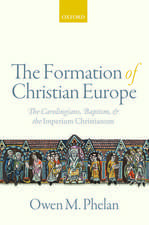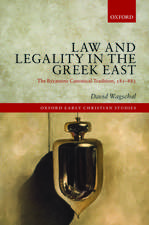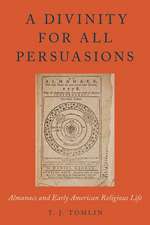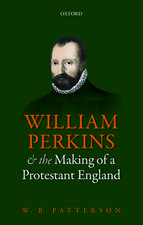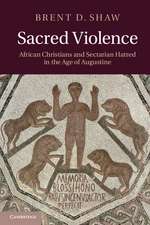Christian Responses to Roman Art and Architecture: The Second-Century Church amid the Spaces of Empire
Autor Laura Salah Nasrallahen Limba Engleză Paperback – 14 aug 2011
Preț: 432.55 lei
Nou
Puncte Express: 649
Preț estimativ în valută:
82.78€ • 89.89$ • 69.53£
82.78€ • 89.89$ • 69.53£
Carte tipărită la comandă
Livrare economică 22 aprilie-06 mai
Preluare comenzi: 021 569.72.76
Specificații
ISBN-13: 9781107644991
ISBN-10: 1107644992
Pagini: 352
Ilustrații: 31 b/w illus. 1 map
Dimensiuni: 178 x 254 x 19 mm
Greutate: 0.61 kg
Editura: Cambridge University Press
Colecția Cambridge University Press
Locul publicării:New York, United States
ISBN-10: 1107644992
Pagini: 352
Ilustrații: 31 b/w illus. 1 map
Dimensiuni: 178 x 254 x 19 mm
Greutate: 0.61 kg
Editura: Cambridge University Press
Colecția Cambridge University Press
Locul publicării:New York, United States
Cuprins
Introduction; Part I. Framing the Question, Framing the World: 1. What is an apology? Christian apologies and the so-called second sophistic; 2. What is the space of the Roman Empire? Mapping, bodies, and knowledge in the Roman World; Part II. Into the Cities: 3. What informs the geographical imagination? The acts of the Apostles and Greek cities under Rome; 4. What is justice? What is piety? What is paideia? Justin, the forum of Trajan in Rome, and a crisis of mimēsis; Part III. Human Bodies and the Image(s) of God(s): 5. How do you know God? Athenagoras on names and images; 6. What do we learn when we look? (Part I) Images, desire, and Tatian's To the Greeks; 7. What do we learn when we look? (Part II) Aphrodite and Clement of Alexandria; Epilogue.
Recenzii
Reviews of the hardback: '… provocative, convincing … reads second-century Christian literature, texts of the Second Sophistic, and the remains of material culture as a broad corpus concerned with the production and contestation of ethnicity, geography, and empire in the high Roman Empire … skilfully couples images, maps, and archaeological reconstructions with lucid written discussions of art and archaeology. Nasrallah's approach challenges received historical narratives that consider Christian literature sui generis … [she] demonstrates that early Christian apologetics emerged from the same political and social milieu as other second-century Greek literature … [she] re-reads 'canonical' second-century texts in terms of spatial and geographic agonism. Although focused in particular on Christian apologetics, Nasrallah shows classicists and ancient historians that any cultural history of second-century culture that ignores early Christian texts is incomplete. A must read for scholars and students of early Christianity, classics, and ancient history … Essential.' J. Schott, Choice
'… we should end our review of Nasrallah's work with a real sense of gratitude for a work of intriguingly suggestive and thoughtful scholarship.' Journal of Ecclesiastical History
'… the book is ambitious in its methodology and reach, but Nasrallah has offered a cogent and well-organised thesis that is well worth reading. This art historian learned some new ways of viewing well-known works of art, which made this a rewarding read.' Journal of Church History
'This excellent book is a delight to read, and should garner the avid attention of anyone interested in early Christianity and its engagement with Roman culture, or in the spatial and material readings of ancient texts more generally. It is hard to do justice to the outstanding quality of the work … or the insights that dot every page. The mastery of the secondary literature both for the ancient texts and for the archaeological examples is enviable in its breadth and depth, as well as its theoretical sophistication. Also deserving of note (and emulation!) is Nasrallah's generous and engaged treatment of her colleagues' work, and her lively, fluid style … an unqualified success at its goal, to 'stimulate the reader's imagination to question the prescriptive rhetoric of elite sources, to think spatially, and to look to archaeological materials as well as literary'.' Journal of the American Academy of Religion
'… we should end our review of Nasrallah's work with a real sense of gratitude for a work of intriguingly suggestive and thoughtful scholarship.' Journal of Ecclesiastical History
'… the book is ambitious in its methodology and reach, but Nasrallah has offered a cogent and well-organised thesis that is well worth reading. This art historian learned some new ways of viewing well-known works of art, which made this a rewarding read.' Journal of Church History
'This excellent book is a delight to read, and should garner the avid attention of anyone interested in early Christianity and its engagement with Roman culture, or in the spatial and material readings of ancient texts more generally. It is hard to do justice to the outstanding quality of the work … or the insights that dot every page. The mastery of the secondary literature both for the ancient texts and for the archaeological examples is enviable in its breadth and depth, as well as its theoretical sophistication. Also deserving of note (and emulation!) is Nasrallah's generous and engaged treatment of her colleagues' work, and her lively, fluid style … an unqualified success at its goal, to 'stimulate the reader's imagination to question the prescriptive rhetoric of elite sources, to think spatially, and to look to archaeological materials as well as literary'.' Journal of the American Academy of Religion
Notă biografică
Descriere
Laura Nasrallah argues that early Christian literature is best understood when read alongside the archaeological remains of Roman antiquity.


